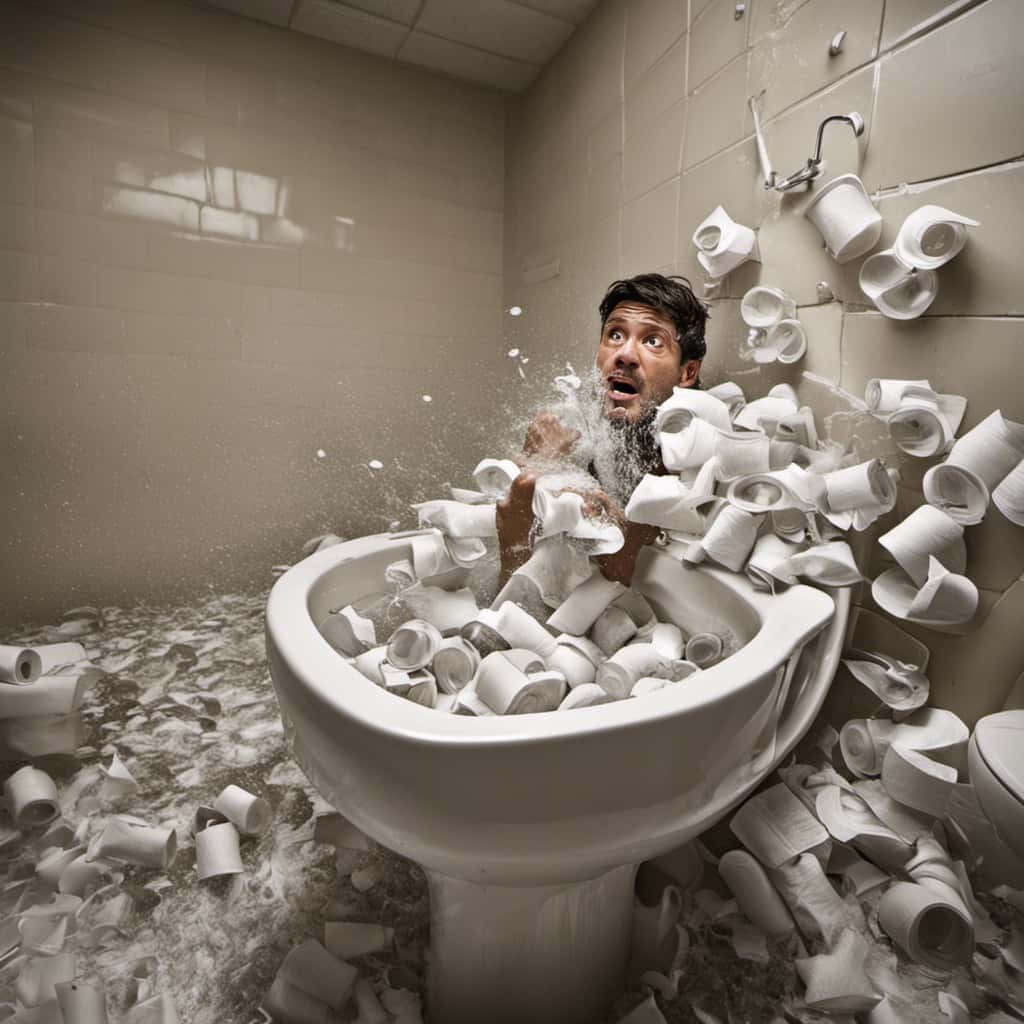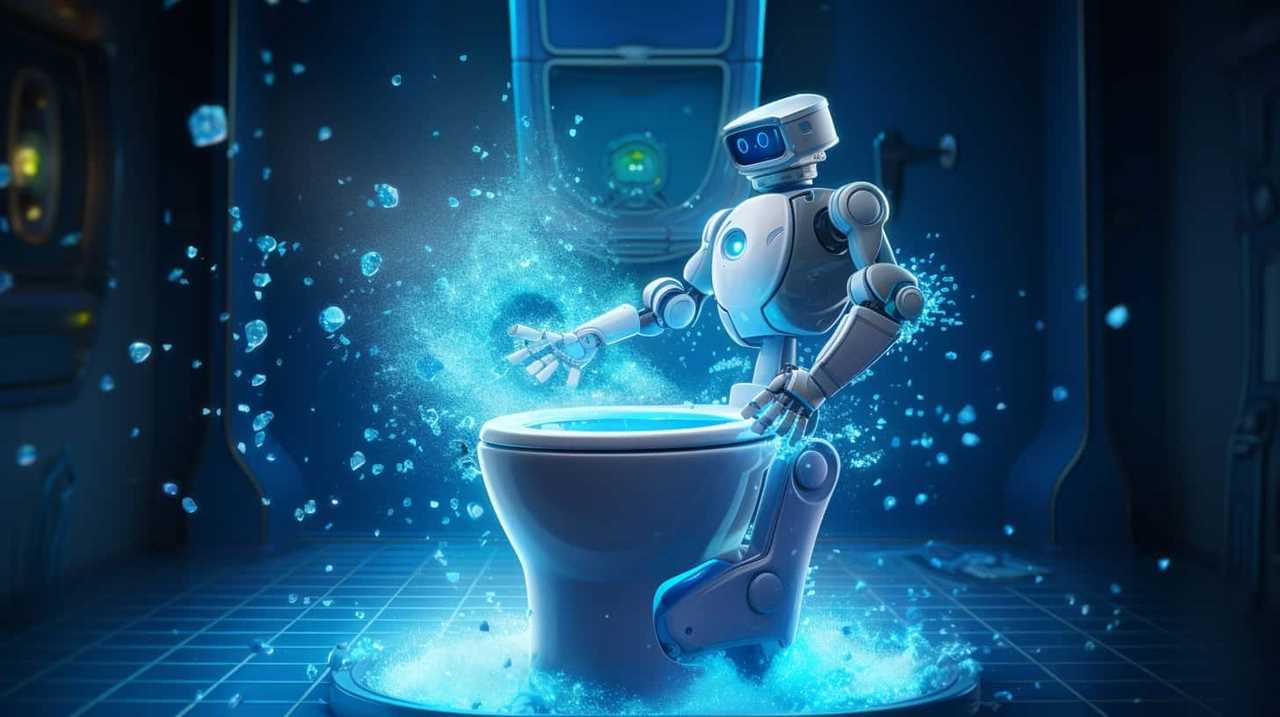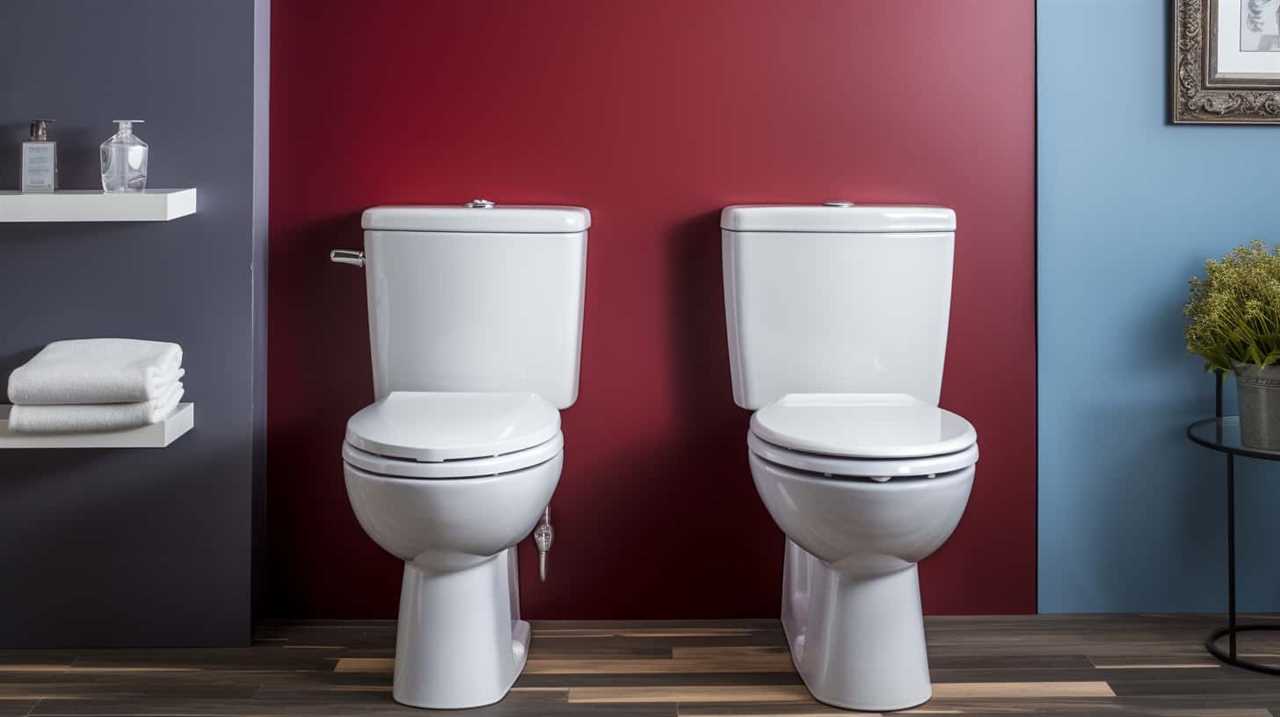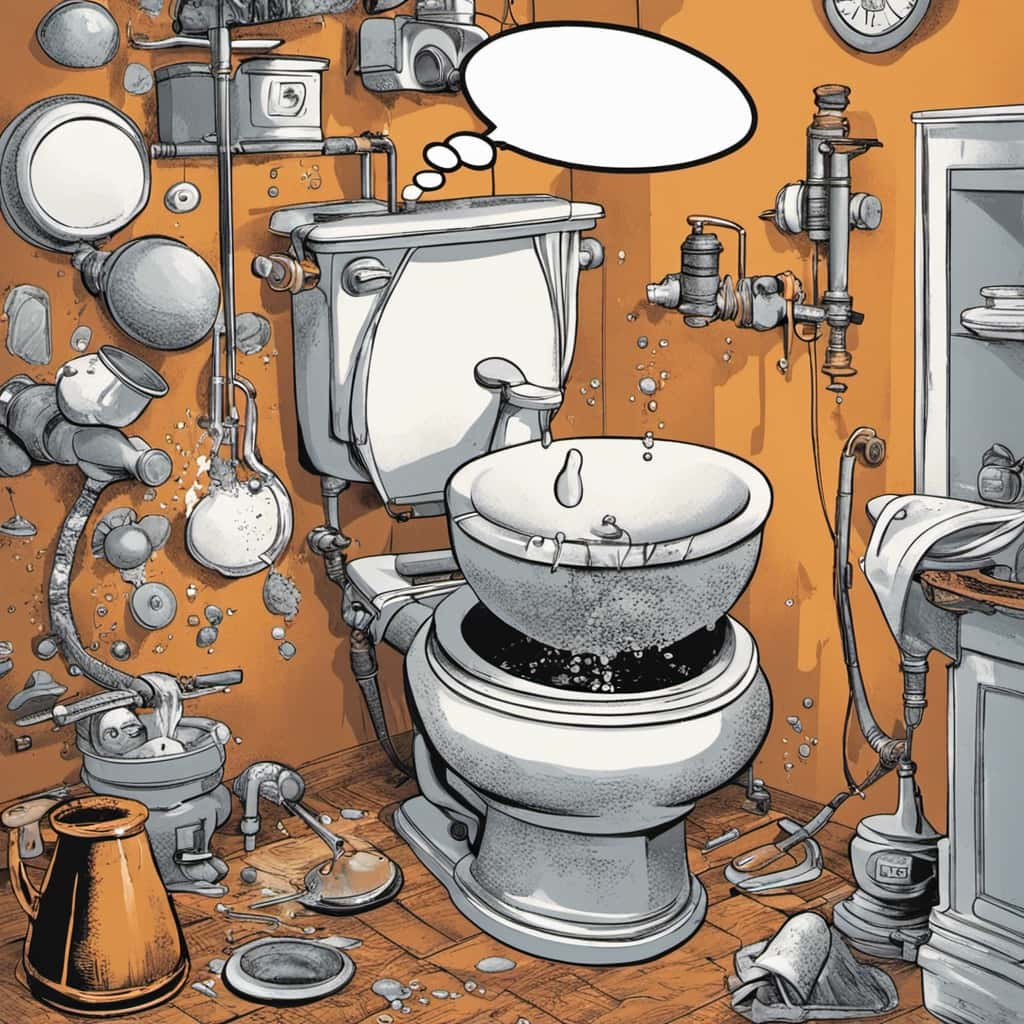FAQ - Advanced Bathroom Queries
How to Tile Around a Toilet

I’ve always found tiling to be a fascinating and rewarding DIY project. And when it comes to tiling around a toilet, it’s all about understanding the basics and following a step-by-step guide.
In this article, I’ll walk you through the process of preparing the area, selecting the right tiles, and tiling around your toilet like a pro. With a little patience and the right tools, you’ll have a beautifully tiled bathroom in no time.
Let’s get started!
Key Takeaways
- Choose the right adhesive for a strong bond between tiles and the floor.
- Prepare the toilet area by inspecting the toilet flange, cleaning the area, and applying a waterproofing membrane.
- Select tiles based on design, color scheme, and material (ceramic, porcelain, or natural stone).
- Follow a step-by-step guide to properly measure, cut, and lay out tiles around the toilet, and apply adhesive for a secure installation.
Understanding the Basics of Tiling
Before you begin tiling around the toilet, it’s important to understand the basics of tiling.
Choosing the right adhesive for tiling is crucial to ensure a strong and long-lasting bond between the tiles and the floor. There are different types of adhesives available, such as cement-based, epoxy, and premixed adhesives. It is essential to choose the adhesive that is suitable for your specific tile and substrate.
Another crucial aspect to consider is avoiding common mistakes when tiling a bathroom. Some of these mistakes include not properly preparing the surface, not using spacers to ensure even spacing between tiles, and not properly sealing the grout lines.
Preparing the Toilet Area for Tiling
To ensure proper tiling, it’s important to first prepare the area around the toilet. This involves taking certain steps to ensure a smooth and waterproof surface. Here are five key items to consider when preparing the toilet area for tiling:
-
Inspect the toilet flange: Check if the toilet flange is in good condition and securely fastened to the floor. If it’s damaged or loose, repair or replace it before proceeding with tiling.
-
Clean the area: Remove any debris, old wax ring, or adhesive from the floor around the toilet. Ensure the surface is clean and level.
-
Apply a waterproofing membrane: Use a waterproofing membrane to protect the subfloor from moisture. Apply it over the area surrounding the toilet, extending it beyond the flange.
-
Cut and dry-fit tiles: Measure and cut the tiles to fit around the toilet flange. Dry-fit the tiles to ensure a proper fit and make any necessary adjustments.
-
Mix and apply tile adhesive: Mix the tile adhesive according to the manufacturer’s instructions. Apply a thin layer of adhesive to the subfloor, covering the area around the toilet flange.
Selecting and Purchasing the Right Tiles
When selecting tiles for your bathroom, consider the overall design and color scheme you want to achieve. Comparing different tile materials is crucial to ensure you choose the right one for your needs.
Ceramic tiles are a popular choice due to their durability and versatility. They come in a variety of colors, sizes, and patterns, allowing you to create the desired aesthetic.
Porcelain tiles are another excellent option as they are highly resistant to moisture and stains.
Natural stone tiles, such as marble or granite, offer a luxurious and elegant look but require more maintenance.
Once you have decided on the material, it’s essential to measure and estimate the tile quantities accurately. This will prevent any shortage or excess during installation.
Now that you have selected and purchased the right tiles, let’s move on to the step-by-step guide to tiling around a toilet.
Step-by-Step Guide to Tiling Around a Toilet
Now that you’ve got the right tiles, let’s take a look at the step-by-step guide for tiling around a toilet.
Here’s how you can properly align tiles around the toilet and deal with uneven surfaces:
- Begin by removing the toilet and cleaning the area thoroughly.
- Measure and mark the center of the toilet flange on the floor.
- Lay out the tiles starting from the center mark, ensuring they are evenly spaced.
- Use a tile cutter or wet saw to cut the tiles to fit around the toilet base and other obstacles.
- Apply adhesive to the back of each tile and press them firmly onto the floor, making sure they are level and aligned.
By following these steps, you can achieve a professional-looking tile installation around your toilet, even if the floor is uneven.
Once the tiling is complete, you can move on to the finishing touches and maintenance tips.
Finishing Touches and Maintenance Tips
Once you’ve finished tiling around the toilet, it’s important to apply grout and sealant to ensure a long-lasting and easy-to-clean surface. Maintaining your newly tiled bathroom floor is key to preserving its beauty and functionality.
Establishing a regular maintenance routine will help keep your tiles looking their best for years to come. To begin, sweep or vacuum the tiled area regularly to remove dirt and debris. For deeper cleaning, use a mild detergent mixed with warm water and a soft sponge or mop. Avoid using abrasive cleaners or harsh chemicals that can damage the tiles or grout.
Additionally, it’s essential to troubleshoot common tiling problems such as cracked or discolored grout. Regularly inspect the grout lines and address any issues promptly by reapplying grout or using a grout sealer.
Conclusion
In conclusion, tiling around a toilet can be a tricky task, but with the right knowledge and tools, it can be accomplished seamlessly.
Remember to understand the basics of tiling, prepare the area properly, and select the right tiles for the job.
Follow the step-by-step guide carefully, ensuring a snug fit around the toilet.
Don’t forget the finishing touches and maintenance tips to keep your newly tiled toilet area looking pristine.
So go ahead, tackle this tiling task with confidence, and transform your bathroom into a stunning masterpiece!
Mateo’s flair for writing is matched only by his keen eye for design. As an interior designer turned writer, Mateo brings a unique perspective. He blends aesthetics with functionality in every piece he pens, providing readers with beautifully crafted content that’s also supremely useful.
Mateo loves exploring the latest bathroom tech trends and is our expert on smart toilets. When he’s not writing or designing, Mateo can be found sketching ideas for his next big project at local coffee shops.
FAQ - Advanced Bathroom Queries
Flush Valve

Welcome, fellow plumbing enthusiasts, to our discussion on the amazing flush valve.
With its unassuming presence and understated functionality, the flush valve silently orchestrates the symphony of water flow within our commodes.
As we delve into the inner workings of this unsung hero, we shall uncover the secrets behind its flawless operation, explore its various incarnations, troubleshoot common maladies, and impart maintenance wisdom to ensure its perpetual efficiency.
Prepare to be enlightened, dear readers, for the flush valve holds the key to lavatory perfection.

Key Takeaways
- Flush valves efficiently remove waste from the toilet bowl and contribute to proper sanitation and hygiene.
- Dual flush valves offer water conservation by saving water for liquid waste and providing a powerful flush for solid waste.
- Regular maintenance of flush valves prevents debris and mineral buildup, helps identify and address potential issues, and saves time and money on costly repairs.
- Troubleshooting common issues with flush valves, such as weak flushing or continuous running, is an important aspect of maintenance and can often be resolved through inspection and adjustment.
Importance of Flush Valve
The importance of a flush valve lies in its ability to efficiently and effectively remove waste from a toilet bowl. Flush valves play a crucial role in maintaining proper sanitation and hygiene in our bathrooms. But their significance goes beyond just cleanliness.
Flush valves also contribute to water conservation, an increasingly important concern in today’s world. By regulating the amount of water used during each flush, flush valves help optimize water usage and reduce unnecessary wastage. This is particularly evident in dual flush toilets, which offer two flushing options – one for liquid waste and another for solid waste.
The benefits of dual flush toilets are twofold: they not only save water by using less for liquid waste, but also ensure a powerful flush when needed for solid waste. Understanding the importance of flush valves sets the stage for exploring how they actually work.
How Flush Valves Work
Often, we rely on flush valves to efficiently remove waste from a toilet bowl and maintain proper sanitation and hygiene in our bathrooms. The flush valve mechanism is a crucial component that enables this process to happen smoothly.

A flush valve typically consists of a valve seat, a valve disc, and a flush lever. When the flush lever is pressed, it lifts the valve disc off the valve seat, allowing water to flow from the tank into the toilet bowl. As the water enters the bowl, it creates a siphon effect that carries away the waste.
The advantages of flush valves include their ability to provide a powerful and thorough flush, preventing clogs and ensuring effective waste removal. They also offer water-saving benefits by allowing for adjustable water volume and controlling the duration of the flush. Additionally, flush valves are durable and require minimal maintenance, making them a reliable choice for commercial and residential applications alike.
Different Types of Flush Valves
After discussing how flush valves work, let’s now delve into the different types of flush valves available in the market. When it comes to flush valve installation, there are two main types to consider: exposed and concealed flush valves.
Exposed flush valves are visible and mounted on the outside of the toilet bowl or urinal, making them easier to access for maintenance and repairs. On the other hand, concealed flush valves are hidden behind the wall or within the toilet fixture, providing a sleek and streamlined appearance.

One popular type of flush valve is the dual flush valve, which offers the benefits of water conservation and efficiency. Dual flush valves allow users to choose between a full flush for solid waste and a partial flush for liquid waste, reducing water usage and saving money on utility bills. This innovative design has gained popularity due to its environmental sustainability and cost-effectiveness.
Common Problems With Flush Valves
As we explore common problems with flush valves, we encounter various issues that can affect their performance and functionality. Here are four common problems you may encounter with flush valves:
- Inadequate flushing: If your flush valve isn’t providing enough water to clear the bowl properly, it may be due to a clog or a faulty flush valve mechanism. Troubleshooting flush valves involves checking for any obstructions in the water flow and ensuring that the flush valve is opening and closing properly.
- Continuous running: If your flush valve keeps running even after the tank is full, it could be a sign of a worn-out flapper or a faulty fill valve. DIY flush valve repairs in this case may involve replacing the flapper or adjusting the fill valve to stop the continuous running.
- Weak flush: A weak flush can be caused by a partially clogged flush valve or a low water level in the tank. Troubleshooting flush valves in this case requires cleaning the valve and adjusting the water level to ensure a strong and effective flush.
- Leaking water: If you notice water leaking from the base of the flush valve or from the tank, it could be due to a worn-out gasket or a loose connection. DIY flush valve repairs for leaks involve replacing the gasket or tightening the connections to prevent water leakage.
Maintenance Tips for Flush Valves
To ensure optimal performance and longevity, regular maintenance is essential for flush valves. Implementing a maintenance routine offers several benefits.
First and foremost, it helps prevent clogs and reduces the likelihood of valve malfunctions. By regularly inspecting and cleaning the valve, you can remove any debris or mineral buildup that may hinder its proper functioning.

Additionally, maintenance allows you to identify and address any potential issues before they escalate, saving you time and money on costly repairs. Troubleshooting common issues is another crucial aspect of maintenance.
If you encounter problems such as weak flushing or continuous running, check the valve’s components, including the flapper, overflow tube, and water supply. A thorough inspection and adjustment can often resolve these issues and restore the valve to its optimal functionality.
Frequently Asked Questions
Can a Flush Valve Be Installed in Any Type of Toilet?
Yes, a flush valve can be installed in any type of toilet. However, it is important to consider the benefits of using a flush valve system and the pros and cons of different types of flush valves.
How Often Should a Flush Valve Be Replaced?
We should replace a flush valve periodically to ensure proper toilet functionality. Signs of a worn-out flush valve include leakage, weak flushing, and constant running water. Regular flush valve maintenance is crucial.

Are There Any Eco-Friendly Flush Valve Options Available?
Yes, there are eco-friendly flush valve options available. These utilize water-saving technology and are made from eco-friendly materials. They are designed to reduce water consumption and promote sustainability in plumbing systems.
Can a Flush Valve Be Repaired, or Does It Need to Be Fully Replaced?
When it comes to repairing flush valves, it’s important to assess the extent of the problem. In some cases, a simple repair can fix common issues like leaks or clogs. However, more severe damage may require a full replacement.
Are There Any Benefits to Using a Dual Flush Valve System?
Using a dual flush valve system has several benefits. It enhances efficiency by allowing users to choose between a full and partial flush, conserving water. This can lead to significant water savings over time.
Conclusion
In conclusion, the flush valve serves as the unsung hero of our daily lives, silently and efficiently ensuring the proper functioning of our toilets.

Like a conductor leading an orchestra, it orchestrates the flow of water, symbolizing the harmony and balance within our plumbing systems.
Its intricate mechanisms, from the float to the diaphragm, work in perfect synchronization, guaranteeing a clean and hygienic flush every time.
With regular maintenance and care, this small yet vital device will continue to uphold the standards of cleanliness in our modern world.
With an impeccable eye for detail and a passion for bathroom-related, Ava leads our editorial team gracefully and precisely.
Under her guidance, Best Modern Toilet has flourished as the go-to resource for modern bathroom enthusiasts. In her free time, you might find Ava exploring antique shops and looking for vintage bathroom fixtures to add to her collection.
FAQ - Advanced Bathroom Queries
Why Won’t My Toilet Flush Without Power

If you’ve ever been stuck in a challenging situation during a power outage, frantically trying to figure out why your toilet isn’t flushing, don’t worry – we’re here to explain this common dilemma.
In this article, we’ll explore the role of electricity in toilet flushing and delve into the components of a power-dependent flushing system. We’ll also uncover the reasons behind toilet flushing failure during power outages and provide alternative methods to ensure a functional toilet, even without power.
So, let’s dive in and master the art of flushing without electricity!
Key Takeaways
- Electricity is essential for the flush mechanism of modern toilets.
- Power outages can disrupt the functioning of the components that control flushing.
- Alternative methods for flushing a toilet without power include manually filling the tank, pouring water into the bowl, or using portable toilet options.
- Preparing for power outages involves installing backup power sources, stocking up on water, considering water-saving toilets, and educating oneself on alternative flushing methods.
The Role of Electricity in Toilet Flushing
In our experience, the main role of electricity in toilet flushing is through the operation of the electrically-powered flush mechanism. This mechanism is responsible for initiating the flushing action by activating the water flow and creating the necessary pressure to remove waste from the bowl.

The impact of water pressure on toilet flushing can’t be overstated. Adequate water pressure ensures a strong and efficient flush, while low water pressure can result in incomplete waste removal and potential clogs.
The history of electricity in toilet technology dates back to the early 20th century when electrically-powered flush mechanisms were first introduced. Since then, advancements in technology have led to more efficient and effective flushing systems, improving overall toilet performance.
Understanding the role of electricity in toilet flushing is crucial for maintaining a properly functioning toilet system.
Components of a Power-Dependent Flushing System
To understand the components of a power-dependent flushing system, we need to examine the inner workings of the toilet. Power saving toilet technology has become increasingly popular due to its ability to reduce energy consumption and minimize the impact of power outages on water pressure. Let’s take a closer look at the key components involved in this system.

| Component | Function |
|---|---|
| Flapper valve | Controls the release of water from the tank into the bowl |
| Fill valve | Regulates the water level in the tank |
| Flush valve | Opens to allow water to flow into the bowl during flushing |
During a power outage, the lack of electricity can disrupt the functioning of these components, particularly the flapper valve. Without power, the flapper valve may fail to open, preventing the water from being released into the bowl. Additionally, the fill valve may not be able to replenish the water in the tank, leading to decreased water pressure and a weaker flush. Understanding these components helps us comprehend why a toilet may not flush without power.
Common Reasons for Toilet Flushing Failure During Power Outages
When power outages occur, we often experience toilet flushing failure due to several common reasons. One of the main causes is the reliance on electricity for the flushing mechanisms of modern toilets. These mechanisms, such as electric pumps or pressure-assisted systems, require power to operate. Without electricity, these mechanisms can’t generate the necessary force to flush the toilet effectively.
Another reason for flushing failure during power outages is a clogged or malfunctioning toilet. Blockages in the pipes or a faulty flush valve can impede the flushing process, even when power is available. Troubleshooting toilet flushing issues should involve checking for blockages, ensuring the flush valve is functioning properly, and considering alternative methods for flushing.
Understanding these common reasons for toilet flushing failure is crucial in finding solutions and ensuring proper functionality, especially during power outages. In the next section, we’ll explore alternative methods for flushing a toilet without power.

Alternative Methods for Flushing a Toilet Without Power
During power outages, when the reliance on electricity for toilet flushing mechanisms renders them ineffective, it’s important to consider alternative methods for flushing a toilet without power.
In emergency situations, there are several solutions that can be implemented to ensure proper sanitation and water conservation.
One option is to manually fill the toilet tank with water using a bucket or container. By pouring the water into the bowl, it will create enough force to flush the waste down the drain.
Another method is to use a portable camping toilet or a portable toilet seat that can be placed on top of a bucket or other container.

These emergency solutions can help maintain hygiene and prevent the spread of diseases during power outages, while also conserving water.
Preparing for Power Outages: Tips to Ensure a Functional Toilet
In order to prepare for power outages and ensure a functional toilet, we can continue the discussion by exploring some helpful tips. Here are three key suggestions to enhance toilet hygiene and emergency preparedness:
- Install a backup power source: Consider investing in a generator or a battery backup system to keep essential appliances, including your toilet, running during power outages. This will allow you to maintain proper sanitation even when the electricity is down.
- Stock up on water: Have an adequate supply of water stored for emergencies. You can use this water to manually flush the toilet by pouring it directly into the bowl. Aim for at least one gallon of water per person per day to cover your basic needs.
- Learn manual flushing techniques: Familiarize yourself with alternative methods for flushing the toilet without power. For instance, you can manually fill the toilet tank using a bucket of water to create enough pressure for a flush.
Frequently Asked Questions
How Does a Power Outage Affect the Operation of a Toilet?
During a power outage, a toilet may not flush because it relies on electricity to activate the flushing mechanism. Without power, the backup generator or emergency plumbing may be needed to restore functionality.
Can I Manually Flush a Toilet That Is Dependent on Electricity?
Yes, you can manually flush a toilet that relies on electricity. By using the emergency toilet flush or manually filling the tank and operating the lever, you can still achieve a functioning flush without power.

Are There Any Alternative Methods to Flush a Toilet Without Power?
Emergency toilet solutions include DIY toilet flush options. When there is no power, alternative methods can be used to manually flush a toilet. These methods ensure functionality during emergencies or power outages.
What Are the Common Reasons for Toilet Flushing Failure During a Power Outage?
The common reasons for toilet flushing failure during a power outage include a lack of power to operate the toilet flushing mechanism and potential issues with the water supply. Troubleshooting toilet flushing may involve checking the power source and ensuring proper water flow.
How Can I Prepare My Toilet for a Power Outage to Ensure It Remains Functional?
To prepare our toilet for a power outage and ensure it remains functional, we can take measures such as installing a backup generator, using water conservation techniques, and considering portable toilet options.
Conclusion
In conclusion, power outages can disrupt the functioning of toilets, which rely on electricity for flushing.

One interesting statistic to consider is that during a power outage, the average person flushes the toilet around 2,500 times per year.
This visualizes the potential inconvenience and importance of having alternative methods in place to ensure a functional toilet during such situations.
With an impeccable eye for detail and a passion for bathroom-related, Ava leads our editorial team gracefully and precisely.
Under her guidance, Best Modern Toilet has flourished as the go-to resource for modern bathroom enthusiasts. In her free time, you might find Ava exploring antique shops and looking for vintage bathroom fixtures to add to her collection.
FAQ - Advanced Bathroom Queries
Are You Allowed to Flush Toilet Paper

Are we overlooking the consequences of flushing toilet paper?
In this article, we explore the environmental consequences and plumbing issues associated with this common practice.
We’ll also delve into alternatives and proper disposal methods recommended by plumbing and environmental experts.
Join us as we navigate the complexities of this topic and gain a deeper understanding of whether we are allowed to flush toilet paper.

Get ready to master the art of responsible waste management.
Key Takeaways
- Flushing toilet paper contributes to water scarcity and wastes valuable water resources.
- Flushing too much toilet paper can lead to clogging and damage to sewage systems.
- Composting toilets and bidet attachments are sustainable alternatives to flushing toilet paper.
- Proper disposal methods, such as recycling and composting, help reduce the environmental impact of toilet paper.
Environmental Impact of Flushing Toilet Paper
Flushing toilet paper has a significant environmental impact, and we should be aware of its consequences. When we flush toilet paper, it contributes to two major environmental issues: water scarcity and deforestation.
Firstly, the production of toilet paper requires a significant amount of water. With water scarcity becoming a growing concern around the world, it’s important to recognize that flushing toilet paper wastes this valuable resource.
Secondly, the production of toilet paper contributes to deforestation. Trees are cut down to make pulp, which is then processed into toilet paper. This deforestation not only destroys ecosystems and habitats but also reduces the Earth’s ability to absorb carbon dioxide.

Therefore, it’s crucial that we consider alternative options, such as using bidets or recycled toilet paper, to minimize the environmental impact of flushing toilet paper.
Plumbing Issues Caused by Flushing Toilet Paper
Although it may seem convenient, flushing toilet paper can lead to various plumbing issues. One of the most common problems is toilet paper clogging. When too much toilet paper is flushed, it can accumulate and create blockages in the pipes. This can result in toilets that do not flush properly or even overflowing toilets. In addition to clogging, flushing toilet paper can also cause damage to the sewage system. The fibers in toilet paper do not break down easily, especially in older plumbing systems. Over time, these fibers can build up and cause damage to the pipes, leading to costly repairs. To illustrate the potential consequences of flushing toilet paper, refer to the table below:
| Plumbing Issues Caused by Flushing Toilet Paper |
|---|
| Toilet paper clogging |
| Sewage system damage |
To avoid these problems, it is best to dispose of toilet paper in a waste bin instead of flushing it. This simple change in behavior can help maintain the integrity of your plumbing system and prevent unnecessary expenses.
Alternatives to Flushing Toilet Paper
To avoid the plumbing issues caused by flushing toilet paper, we can explore alternative methods of disposal.

One such alternative is the use of composting toilets. Composting toilets are designed to efficiently break down human waste, including toilet paper, using natural processes. These toilets separate solid waste from liquid waste and utilize aerobic bacteria to decompose the organic matter. The resulting compost can then be used as a nutrient-rich fertilizer for plants.
Another alternative is the use of bidet attachments. Bidets are devices that use water to clean oneself after using the toilet. Bidet attachments can be easily installed on existing toilets and provide a more hygienic and environmentally friendly option.
Proper Disposal Methods for Toilet Paper
We can dispose of toilet paper properly by simply throwing it in the designated trash bin.
However, there are also other environmentally friendly options for toilet paper disposal. One option is toilet paper recycling. Some companies specialize in recycling toilet paper, where it’s collected, processed, and turned into new paper products. This not only reduces waste but also saves trees and energy.

Another option is composting toilet paper. Composting toilet systems are designed to break down organic waste, including toilet paper, into nutrient-rich compost. This compost can then be used as fertilizer for gardens and plants. It’s important to note that not all toilet paper is suitable for composting, so it’s essential to choose toilet paper that’s specifically labeled as compostable.
Recommendations From Plumbing and Environmental Experts
According to plumbing and environmental experts, our recommendation is to consult with your local water and sanitation authorities for guidelines on flushing toilet paper. These authorities are knowledgeable about the specific waste management systems in your area and can provide you with accurate information on how to properly dispose of toilet paper.
It’s important to follow their guidelines to ensure the efficient and environmentally friendly management of toilet paper waste.
Additionally, it’s worth considering eco-friendly toilet paper options, which are becoming increasingly popular. These options are made from recycled materials or sustainable sources, reducing the environmental impact associated with traditional toilet paper production.

Frequently Asked Questions
Is It True That Flushing Toilet Paper Can Cause Plumbing Issues?
Flushing toilet paper can cause plumbing issues. The plumbing consequences include clogged pipes and potential damage to the septic system. It is important to properly dispose of toilet paper in a waste bin to prevent these problems.
What Are Some Alternative Options to Flushing Toilet Paper?
When it comes to the question of alternative options to flushing toilet paper, one option that comes to mind is using a bidet. The benefits of using bidets include improved hygiene and reduced paper waste.
How Should Toilet Paper Be Properly Disposed Of?
Toilet paper should be properly disposed of by either recycling it or composting it. Recycling toilet paper helps to reduce waste, while composting toilet paper allows it to break down naturally and become a nutrient-rich soil amendment.
What Are the Recommendations From Plumbing Experts Regarding Toilet Paper Usage?
Plumbing experts recommend considering toilet paper alternatives and eco-friendly options. It’s essential to be mindful of proper disposal methods and not flush non-flushable items to prevent clogs and damage to the plumbing system.

How Does Flushing Toilet Paper Impact the Environment?
Flushing toilet paper can have a negative impact on the environment. Toilet paper production contributes to deforestation, as trees are cut down to make it. Proper disposal methods, such as using a designated bin, can help mitigate these effects.
Conclusion
In conclusion, it’s crucial to consider the environmental impact and potential plumbing issues caused by flushing toilet paper.
Instead, explore alternatives such as bidets or wet wipes that can be disposed of properly.
By doing so, we can help preserve our planet and avoid costly plumbing repairs.

Remember, like a drop in a vast ocean, our small choices can create ripples of positive change.
With an impeccable eye for detail and a passion for bathroom-related, Ava leads our editorial team gracefully and precisely.
Under her guidance, Best Modern Toilet has flourished as the go-to resource for modern bathroom enthusiasts. In her free time, you might find Ava exploring antique shops and looking for vintage bathroom fixtures to add to her collection.
-

 FAQ - Advanced Bathroom Queries2 months ago
FAQ - Advanced Bathroom Queries2 months agoWhich Countries Use Bidets the Most
-

 Reviews3 months ago
Reviews3 months agoBest Waterless Toilets: Top Options for Eco-Friendly Bathrooms [2024]
-

 Reviews2 weeks ago
Reviews2 weeks agoLDian Smart Toilet Review [2024]
-

 Buying Guides3 months ago
Buying Guides3 months agoWhat to Do When You Accidentally Flushed Something Down the Toilet
-

 Reviews3 months ago
Reviews3 months agoBest Toilet Enzyme Cleaners for Optimal Odor Control [2024]
-

 Reviews2 months ago
Reviews2 months agoKohler Innate Smart Toilet Review [2024]
-

 Reviews2 months ago
Reviews2 months agoKohler NUMI 2.0 Smart Toilet Review [2024]
-

 Guides3 months ago
Guides3 months agoWhat Happens if You Pour a Bucket of Water in the Toilet






















